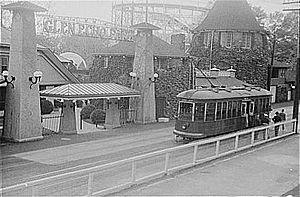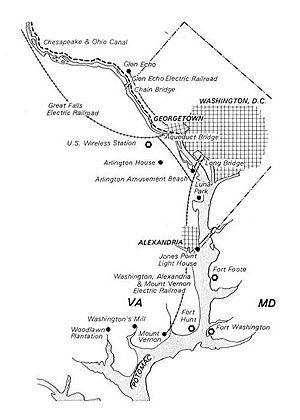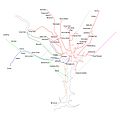Streetcars in Washington, D.C facts for kids
Streetcars and interurbans were like early electric trains that ran on tracks in the streets and between towns. They were a popular way to travel in the Maryland suburbs of Washington, D.C., from 1890 until 1962. Even though each line started as its own company, they eventually all became part of a larger system called DC Transit. Unlike the streetcar lines in Virginia, the Maryland and D.C. lines worked together as one big network. Many of these streetcar lines had big plans to make lots of money, but none of them really succeeded. As more people started using cars, and due to tough economic times, these streetcar lines eventually closed down. Sometimes, buses replaced the streetcars on their routes.
Contents
- Streetcar Companies in Maryland
- Tennallytown and Rockville Railroad
- Glen Echo Railroad
- Washington & Great Falls Electric Railway
- City and Suburban Railway
- Washington, Woodside and Forest Glen Railway Power Company
- The Kensington Railway
- The Baltimore and Washington Transit Company
- The Washington, Spa Spring and Gretta Railroad Company
- The Washington and Great Falls Railway and Power Company
- Interurban Lines
- Trolley Parks
- Images for kids
Streetcar Companies in Maryland
Tennallytown and Rockville Railroad
This streetcar line opened in 1890. It was an extension of another line that ran from Georgetown in D.C. It went from Western and Wisconsin Avenue NW all the way to Rockville, Maryland. It used Wisconsin Avenue, Old Georgetown Road, and its own special path. Over time, it was bought by different companies, including the Washington and Rockville Electric Railway Company and then the Washington Railway and Electric Company. In 1935, buses took over its route.
Some places where you can still see parts of this old line include:
- Wisconsin Avenue and Old Georgetown Road (which are still busy roads today).
- The North Bethesda Trail, which is a walking and biking path built on the old streetcar route.
- Woodglen Drive in Rockville.
Glen Echo Railroad
The Glen Echo Railroad started running on June 10, 1891. It connected Glen Echo Park to the Tennallytown & Rockville Railroad in Friendship Heights. In 1896, it grew longer and reached Cabin John, changing its name to the Washington & Glen Echo Railroad. Soon after, it was extended eastward to Chevy Chase Circle, where it connected with another line called the Rock Creek Railway. This line stopped running in 1900, but the part from Glen Echo to Cabin John became part of the Washington & Great Falls Electric Railway.
You can still see some old railroad tracks and where a bridge used to be in Willard Avenue Neighborhood Park in Bethesda, Maryland.
Washington & Great Falls Electric Railway
This railway started in 1895. It began in Georgetown, D.C., and followed a special path along the Washington Aqueduct lands to Glen Echo. From there, it used the old Glen Echo Railroad tracks to reach Cabin John. People often called it the "Cabin John Trolley" because it never actually reached Great Falls as its name suggested. The Washington Railway and Electric Company bought it in 1902. The railway was taken apart in the 1960s, but you can still see where its path used to be in The Palisades, D.C., and Montgomery County, Maryland.
Some parts of the line you can still find in Montgomery County are:
- An old bridge (called a trestle) over Walhonding Brook.
- Another old bridge over Minnehaha Branch near Glen Echo Park.
- A third old bridge over Braeburn Branch.
- Much of the original path from Brookmont to the Cabin John Parkway still exists.
City and Suburban Railway
The City and Suburban Railway was planned in 1890 to run a streetcar from near the White House in D.C. to Mount Rainier, Maryland. Another company, the Maryland and Washington Railway, was formed in 1892 to build a line connecting D.C. railways to Branchville and eventually Laurel, Maryland.
In 1896, the Maryland and Washington company joined with other struggling streetcar companies to form the Columbia and Maryland Railway.
Meanwhile, the City and Suburban Railway was busy laying tracks. It reached Mount Rainier in 1897 and then merged with the Eckington & Soldiers Home Railroad in 1898. It kept building tracks into Maryland, reaching Brentwood in 1898, and Hyattsville and Riverdale in 1899.
The Columbia and Maryland company changed its name to the Berwyn and Laurel Electric Railroad Company. It started building tracks from Riverdale to College Park and Laurel by 1902. Then it changed its name again to the Washington, Berwyn and Laurel Electric Railroad Company.
Eventually, the City and Suburban company took control of the Washington, Berwyn and Laurel line. Later, the Washington Railway and Electric Company took over the City and Suburban line itself.
This line had stops in many Maryland towns, including:
- Hyattsville
- Riverdale
- College Park
- Lakeland
- Berwyn
- Branchville
- Beltsville
- Contee
- Laurel
You can still find some reminders of this line:
- Old stations at 4701 Queensbury Road in Riverdale Park and 531 Main Street in Laurel (now Oliver's Old Towne Tavern).
- A bus turnaround in Mount Rainier used to be a streetcar turnaround.
- The College Park Trolley Trail is a walking and biking path built on part of the old streetcar route.
Washington, Woodside and Forest Glen Railway Power Company
This line, also known as the "Forest Glen Trolley," opened on November 25, 1897. It was about 2.9 miles long, and a single ride cost five cents. It ran from Eastern Avenue and Georgia Avenue in D.C. along Georgia Avenue and then Seminary Road to the National Park Seminary, which was a fancy school for girls in Forest Glen, Maryland. This line had competition from passenger trains on the Baltimore and Ohio Railroad. The trolley line closed on December 15, 1924, because a new underpass was being built for Georgia Avenue under the railroad tracks. Even though the underpass was built with a lane for trolley tracks, the trolley never started running again.
The stations on this line were:
- Silver Spring
- Sligo
- Woodside
- Forest Glen
The Kensington Railway
The Kensington Railway started operating on May 30, 1895. It was first called the Chevy Chase Lake & Kensington Railway, but changed its name in 1902. It was a single-track line that began at Chevy Chase Lake and went north along what is now Kensington Parkway to a station in Kensington. From 1923 to 1933, another company called Capital Traction leased the line. But in 1935, the line was closed down.
A remnant of this line is:
- Kensington Parkway in Kensington, Maryland.
The Baltimore and Washington Transit Company
This company started building an electric street railway system in 1897. People called it the "Dinky Line." It started in D.C. and went into Maryland, continuing on Ethan Allen Avenue until it reached the very popular Wildwood Resort and Glen Sligo Hotel on Sligo Creek. In 1903, the Takoma Park city council took over the lease because the resort was closed for illegal gambling. The tracks were removed about two years later. In 1920, the hotel was torn down, and the land was divided into individual lots for houses. By 1937, all the tracks were completely taken apart.
The Washington, Spa Spring and Gretta Railroad Company
This single-track trolley line began in 1910. It ran from a car barn in D.C. along Bladensburg Road to Bladensburg, Maryland. The original plan was for the line to go all the way to Gettysburg, Pennsylvania, but it only reached Berwyn Heights, Maryland, in 1912. This line became the Washington Interurban Railway in 1912 and then the Washington Interurban Railroad Company in 1916. In 1923, buses replaced the streetcars, and the tracks were removed when Bladensburg Road was paved.
The Washington and Great Falls Railway and Power Company
This single-track line started operating on July 2, 1913. It connected with the Tennallytown and Rockville Railroad at Bradley Lane and Wisconsin Avenue. It then ran along Bradley Boulevard to River Road, and from there, it followed its own path to Great Falls. Service stopped on February 12, 1921, and the tracks were removed in 1926.
A small part of this line you can still see is the Gold Mine Spur Trail in Chesapeake and Ohio National Historical Park. About 1000 feet of this trail uses the old rail bed of the Washington and Great Falls line.
Interurban Lines
Interurbans were like longer-distance streetcars that connected cities.
- The Washington, Baltimore and Annapolis Electric Railroad operated from 1908 to 1935.
Trolley Parks
Many streetcar companies built or supported "trolley parks" at the end of their lines. These were amusement parks or recreation areas designed to encourage people to ride the streetcars, especially on weekends.
Images for kids




